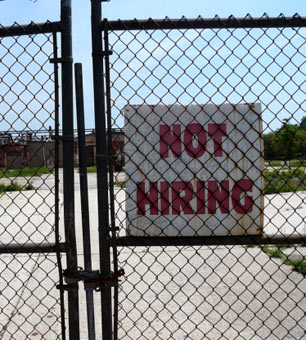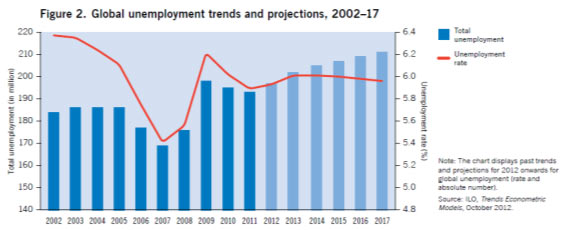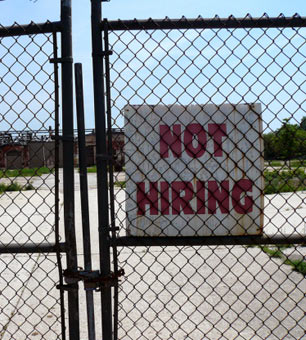 (Photo: WFIU Public Radio / Flickr)After the near collapse of the financial system and the Great Recession, unemployment has significantly increased worldwide. According to the ILO Global Employment Trends 2013 report, a special edition warranted by the global employment crisis, the global unemployment rate is around 6 percent, which translates into a total of 197 million unemployed worldwide – and this number does not include the 39 million who have dropped out of the labor market.
(Photo: WFIU Public Radio / Flickr)After the near collapse of the financial system and the Great Recession, unemployment has significantly increased worldwide. According to the ILO Global Employment Trends 2013 report, a special edition warranted by the global employment crisis, the global unemployment rate is around 6 percent, which translates into a total of 197 million unemployed worldwide – and this number does not include the 39 million who have dropped out of the labor market.
The report estimates that in 2013 the number of unemployed will reach 202 million and in 2013 that number will rise to 205 million. Of these, 73.8 million are young people; the youth unemployment rate is 12.6 percent.

The ILO report points out that:
“[t]he length and depth of the labor market crisis is worsening labor market mismatch, contributing to extended spells of unemployment. As the crisis spreads through international trade, occupations concentrated in exporting industries are particularly vulnerable and in several countries their importance in total employment has declined by significant margins.”
Furthermore,
“Labor force participation has fallen dramatically, in particular in advanced economies, masking the true extent of jobs crisis. The problem is particularly severe in the developed economies and European Union region where the labor force participation rate declined by close to one percentage point and is expected to recede further as long-term unemployment and a weak economic outlook discourages people from staying in the labor market. As a consequence, the employment-to-population ratio has fallen sharply – in some cases 4 percentage points or more – and has not yet recovered even in cases where the unemployment rate has started to decline.”
The situation is worse for the youth:
“Young people remain particularly stricken by the crisis. Currently, some 73.8 million young people are unemployed globally and the slowdown in economic activity is likely to push another half-million into unemployment by 2014. The youth unemployment rate – which had already increased to 12.6 percent in 2012 – is expected to increase to 12.9 percent by 2017. . . Currently, some 35 percent of all young unemployed have been out of a job for six month or longer in advanced economies, up from 28.5 percent in 2007.”
In Europe the situation is particularly severe, as 12.7 percent of all young people are neither employed nor in education or training.
It’s not only the ILO that is focusing on the unemployment crisis these days. The World Bank’s 2013 World Development Report is focused on jobs. While the World Bank wants to promote private sector initiatives for creating jobs, it still has some useful numbers to understand the problem. For example, it estimates that:
“Almost 2 billion working-age adults, the majority of them women, are neither working nor looking for work, but an unknown number of them are eager to have a job…”
The ILO notes that while rising unemployment is putting downward pressure on wages in advanced economies, worldwide, 397 million workers are living in extreme poverty and 472 million cannot address their basic needs. And the World Bank notes that for a great number of workers in poorer countries, the reality is that even holding more than one job and working long hours (often without basic rights and in unsafe conditions), they do not earn enough to provide for themselves and their children.
In short, it is becoming more and more obvious that capitalism does not create enough jobs for the people and when it does create jobs, a great majority of them are not allowing people to secure humane living conditions.
Our most important fundraising appeal of the year
December is the most critical time of year for Truthout, because our nonprofit news is funded almost entirely by individual donations from readers like you. So before you navigate away, we ask that you take just a second to support Truthout with a tax-deductible donation.
This year is a little different. We are up against a far-reaching, wide-scale attack on press freedom coming from the Trump administration. 2025 was a year of frightening censorship, news industry corporate consolidation, and worsening financial conditions for progressive nonprofits across the board.
We can only resist Trump’s agenda by cultivating a strong base of support. The right-wing mediasphere is funded comfortably by billionaire owners and venture capitalist philanthropists. At Truthout, we have you.
We’ve set an ambitious target for our year-end campaign — a goal of $240,000 to keep up our fight against authoritarianism in 2026. Please take a meaningful action in this fight: make a one-time or monthly donation to Truthout before December 31. If you have the means, please dig deep.
